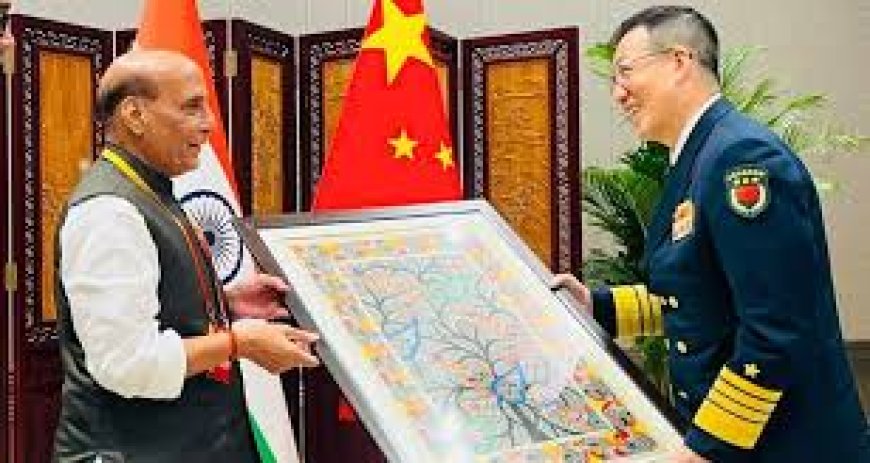Rajnath Singh meets Chinese counterpart Don Jun, gifts him Madhubani painting from Bihar
Indian Defence Minister Rajnath Singh meets Chinese counterpart Dong Jun at SCO meet, gifts traditional Madhubani painting to promote cultural diplomacy amid ongoing border tensions.

A Renewed Diplomatic Push
In a move signalling a softening of recent bilateral strains, Indian Defence Minister Rajnath Singh met with his Chinese counterpart, General Dong Jun, on the sidelines of the Shanghai Cooperation Organisation (SCO) Defence Ministers’ meeting in Astana, Kazakhstan, on Thursday. This face-to-face interaction marks one of the highest-level defence dialogues between the two Asian giants since the deadly 2020 Galwan Valley clash.
In a symbolic gesture that combined diplomacy with India’s cultural heritage, Singh presented General Dong Jun with a Madhubani painting from Bihar—an indigenous art form known for its intricate patterns and vibrant depictions of mythology and nature. The gift was widely interpreted as a message of goodwill and peace, signaling India’s willingness to engage constructively despite ongoing border tensions.
Focused Dialogue on LAC, Regional Stability
During the bilateral talks, Singh underscored the importance of "peace and tranquillity along the Line of Actual Control (LAC)" as a prerequisite for normalizing ties. "Violations of existing agreements have eroded trust," Singh reportedly told Dong, according to sources in the Indian Defence Ministry. The Indian side reiterated its demand for complete disengagement in Eastern Ladakh and the restoration of the status quo ante prior to May 2020.
General Dong Jun, in response, emphasized the need for both countries to “properly manage differences and strengthen military-to-military communication.” Chinese media described the meeting as “candid, constructive, and cooperative,” reflecting Beijing’s interest in de-escalation, possibly driven by economic and geopolitical recalibrations.
Analysts Weigh In: “Culture as a Diplomatic Lever”
Experts viewed the Madhubani painting gift as more than just a ceremonial act. Dr. Aparna Pande, a South Asia expert at the Hudson Institute, commented, “India is using cultural diplomacy to project soft power. The painting embodies tradition, peace, and storytelling—something China’s leadership understands well. It’s a silent reminder that despite hard power posturing, there is scope for civilizational dialogue.”
Similarly, strategic analyst Lt. Gen. (Retd) D.S. Hooda said, “This meeting and the symbolic gift suggest India is leaving the door open for dialogue, but not at the cost of national security. It’s diplomacy with a spine.”
Economic and Strategic Context
The Singh-Dong dialogue takes place amid rapidly evolving strategic realities in the Indo-Pacific. India has deepened its security ties with the U.S., Japan, and Australia under the Quadrilateral Security Dialogue (Quad), while China continues its naval expansion and influence-building in South Asia and the Indian Ocean Region.
Meanwhile, bilateral trade between India and China continues to flourish—crossing $135 billion in 2024—but remains heavily tilted in China's favor. India has placed restrictions on Chinese tech firms and investment in critical sectors, citing national security concerns.
This meeting could ease some investor apprehensions over geopolitical risks that have weighed on India’s market sentiment. While defence sector equities remained flat post-announcement, some analysts foresee potential easing in regional tensions as a positive for defence manufacturers, infrastructure, and energy sectors sensitive to geopolitical disruptions.
Investor Outlook: Watch for Stability Premium
Market analysts suggest keeping an eye on defence and infrastructure stocks in the coming quarters. According to Dipan Mehta, Director at Elixir Equities, “While this meeting won’t immediately move markets, it sets a tone. A stable northern border allows India to redirect capital towards domestic growth and infrastructure buildout. If there’s a sustained thaw, companies like Bharat Electronics, HAL, and L&T Defence could see valuation upside.”
Foreign Institutional Investors (FIIs) are also expected to monitor how India balances its strategic autonomy with regional peace initiatives. As one analyst at HSBC Global Research noted, “Any diplomatic normalization with China, even incremental, adds a premium of predictability to the India investment story.”
Cultural Diplomacy: A Growing Trend
This isn't the first time Indian leaders have used traditional art as a diplomatic token. Prime Minister Narendra Modi has gifted Pattachitra paintings from Odisha, handwoven stoles, and Khadi fabric in various international forums. By choosing Madhubani—a style dating back to the Ramayana era and deeply rooted in Bihar's culture—Singh sent a powerful message of civilizational dialogue.
The painting, created by women artisans from Mithila, symbolized not just beauty but resilience and cultural identity. Observers noted that India may continue to leverage such soft-power assets to humanize high-stakes geopolitical engagement.
A Small Step with Substantial Implications
While Singh’s meeting with Dong Jun did not produce a dramatic breakthrough, it set a constructive tone for further dialogue. The cultural exchange, marked by the presentation of a Madhubani painting, emphasized India’s preference for peace, sovereignty, and mature diplomacy.
In the coming weeks, attention will turn to how both nations follow up—particularly through military-to-military talks and any de-escalation along the LAC. For now, the Madhubani painting hangs not just as a decorative piece but as a canvas of hope for Asia’s two largest powers.
What's Your Reaction?
 Like
0
Like
0
 Dislike
0
Dislike
0
 Love
0
Love
0
 Funny
0
Funny
0
 Angry
0
Angry
0
 Sad
0
Sad
0
 Wow
0
Wow
0












































































